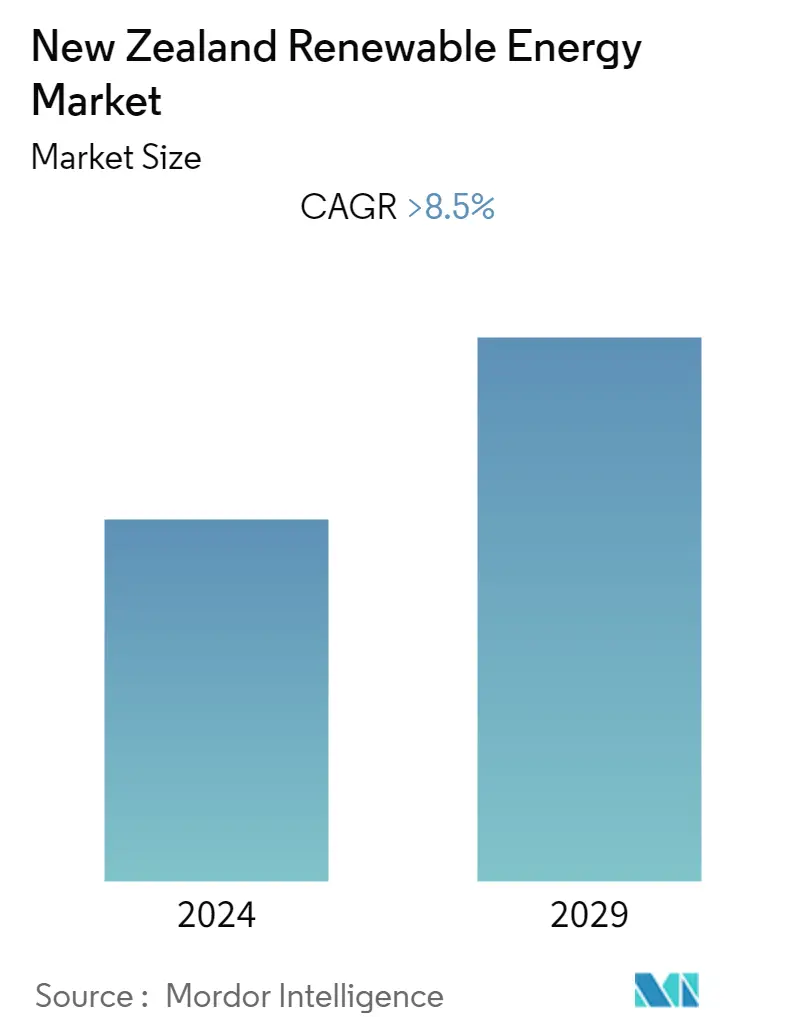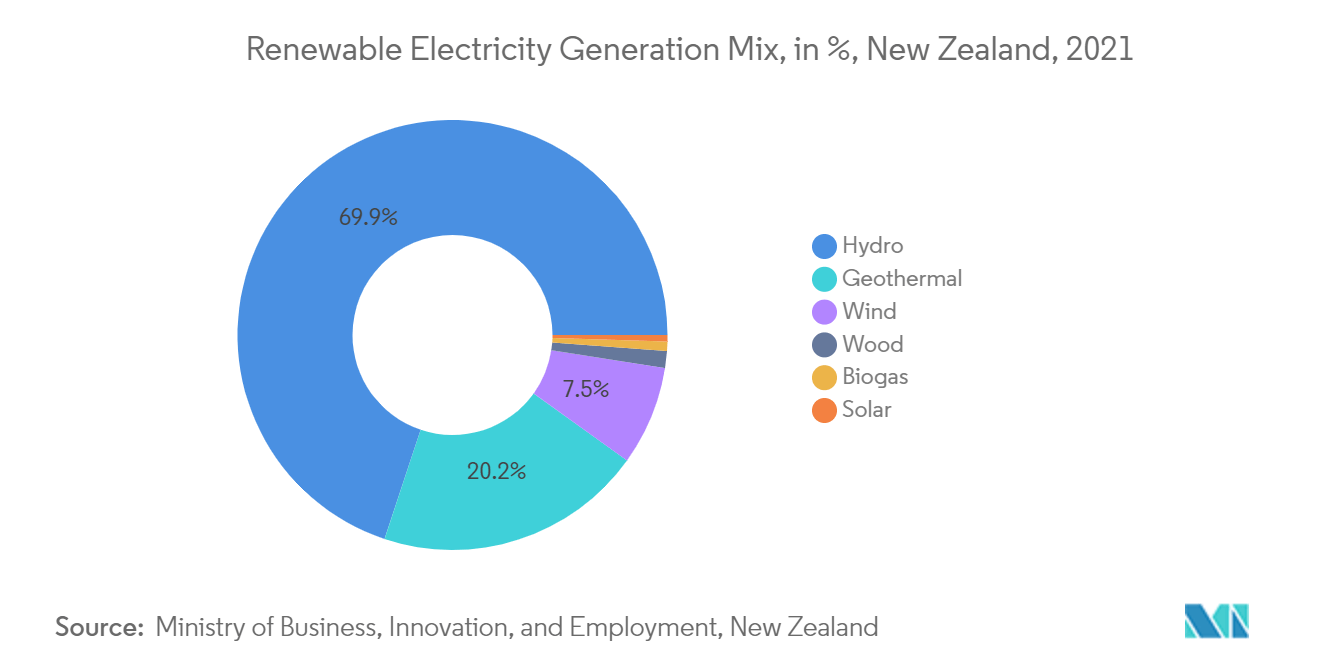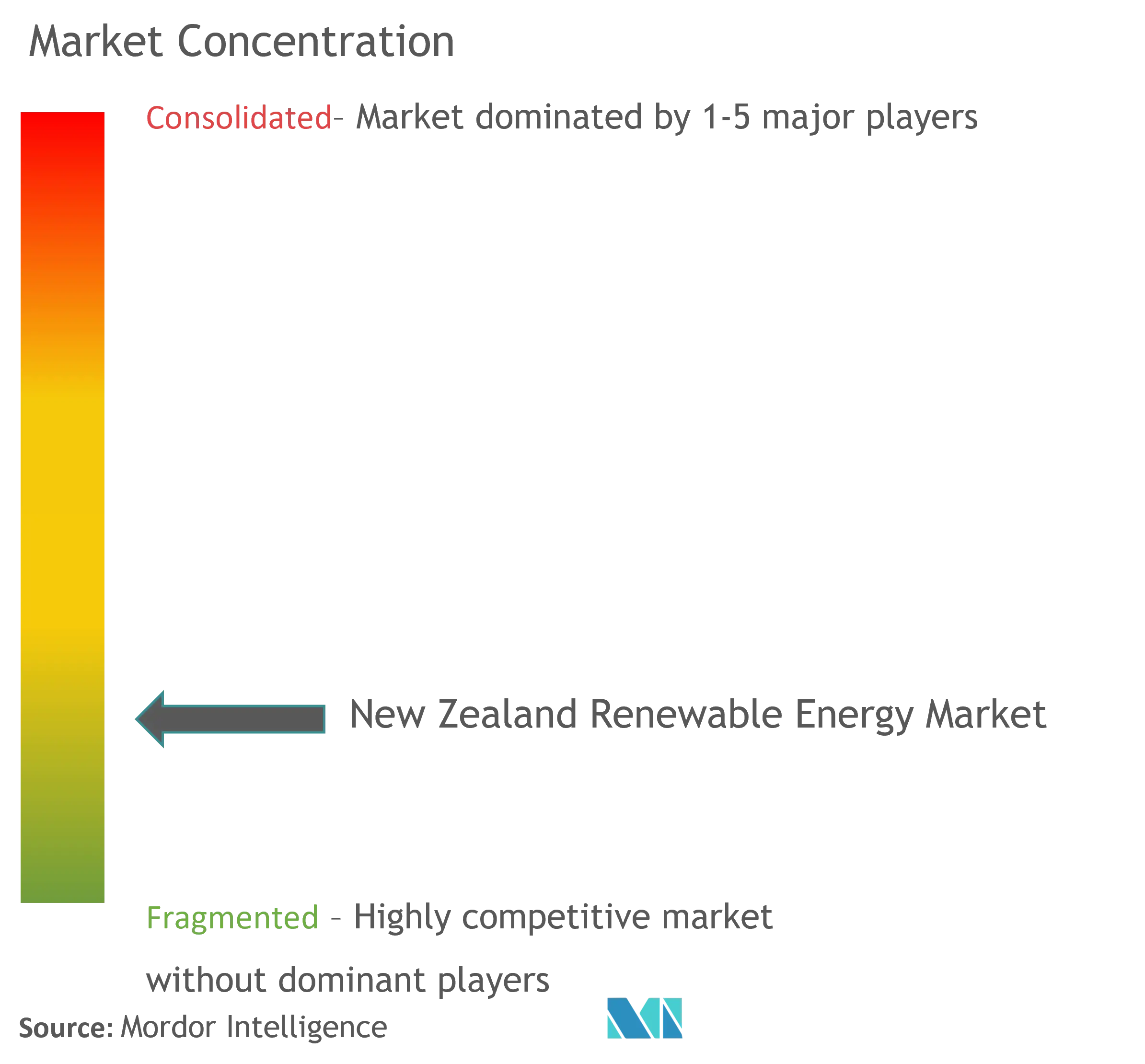New Zealand Renewable Energy Market Size

| Study Period | 2020 - 2029 |
| Base Year For Estimation | 2023 |
| Forecast Data Period | 2024 - 2029 |
| Historical Data Period | 2020 - 2022 |
| CAGR | 8.50 % |
| Market Concentration | Medium |
Major Players
*Disclaimer: Major Players sorted in no particular order |
New Zealand Renewable Energy Market Analysis
The New Zealand renewable energy market is expected to witness a CAGR of around 8.5% during the forecast period. The COVID-19 pandemic had an impact on the already operating renewable energy plants' power supply loads due to decreased power demand from many sectors in the country, ascribed to suspended economic activity. However, the ongoing renewable developments were untouched by the pandemic. For instance, the solar capacity additions in 2020 were around 142MW, an uptrend from the 2019 figures, i.e., 116MW. The New Zealand renewable energy market is expected to grow more in the near future due to the abundant resource base in the country and the government's push for more adoption of renewables in the energy sector. However, the limited land availability in the country is expected to render a stunted growth of the market.
- The wind energy segment is expected to witness significant growth during the forecast period due to the maturing technology.
- The steady efforts on the part of the nation to eject non-renewable resources from the primary energy mix create an enormous opportunity for the growth of the renewable energy market. As an example, in fresh headlines, the New Zealand government has pledged to phase out coal-based technology for power generation in the next 10-20 years at the recently convened United Nations Climate Summit.
- The government policies to promote renewable energy use in the electricity portfolio are likely to bolster the market growth.
New Zealand Renewable Energy Market Trends
This section covers the major market trends shaping the New Zealand Renewable Energy Market according to our research experts:
Wind Energy is Expected to Witness Significant Growth
- New Zealand has been a success story in the field of renewable power generation, with a major share of renewables in the electricity mix. The sector is extremely developed, with wind, hydro, and geothermal technologies almost approaching their maturity level in the country. Wind technology has reached 100% electrical efficiency power.
- Wind power technology accounted for around 7% of the renewable power generation mix in 2021. The years 2020 and 2021 saw many new additions in the wind power capacity of the country. The September quarter of 2020 saw the highest ever generation from wind for a September quarter, exceeding 600 GWh. The country has planned new wind farm projects to increase the wind energy share in the coming years.
- In February 2021, the New Zealand-based renewable energy company Meridian Energy announced plans to establish a 176MW wind farm in the country. The company is likely to spend USD 291million (NZD 395 million) on the installation of 41 turbines for the Harapaki Wind Farm in Hawke's Bay, North Island. The project is likely to produce 176MW of power output when commissioned in 2024.
- Furthermore, Mercury Energy is currently working on a wind farm project, Turitea Stage 2 wind farm, in the country. The 103MW (annual capacity around 370GWh) capacity project is currently under construction, and it is expected to be in service by 2023.
- Further, the country has several other upcoming wind energy projects, on account of which the segment is expected to grow at the fastest rate during the forecast period.

Government Initiatives are Expected to Drive the Market
- The government of New Zealand has so far been highly successful in making the country a green economy, with a major share of renewables in total primary energy consumption. The government programs and policies to develop the sector have been the most important catalyst for the growth of the market.
- Renewable energy sources hold a share of around 83% of the net electricity generation mix as of 2021. The country has planned the net-zero emissions or 100% renewable energy generation by 2030. Many projects have been approved by the government, along with policies implemented to reach the target.
- For example, in August 2020, the government announced new fund allocations for installing renewable energy technologies in Māori (All the inhabitants of New Zealand) and public housing. The USD 28 million Māori and Public Housing Renewable Energy Fund has been established for selected projects to be implemented in the residential sector over four years until 2024 through an open application process.
- Furthermore, in 2020, the New Zealand government allocated a USD 219.5 million fund to decarbonize the state sector. The state sector includes public sector hospitals, universities, and an estimated 90 schools. The investments to date under the program are expected to reduce carbon emissions by an estimated 292,000 over ten years.
- Such developments are expected to foster renewables in the energy sector to the greatest extent.

New Zealand Renewable Energy Industry Overview
The New Zealand renewable energy market is moderately fragmented. The major companies include Contact Energy Limited, Vestas Wind Systems AS, Genesis Energy L.P., General Electric Company, and Meridian Energy Limited.
New Zealand Renewable Energy Market Leaders
-
Contact Energy Limited
-
Genesis Energy L.P.
-
General Electric Company
-
Meridian Energy Limited
-
Vestas Wind Systems A/S
*Disclaimer: Major Players sorted in no particular order

New Zealand Renewable Energy Market News
- In September 2021, the UK solar project developer Hive Energy, Ethical Power, and Solar South West (SSW) formed a joint venture (JV) to deploy around 350 MW of utility-scale photovoltaic (PV) capacity in New Zealand. The joint venture will work together to support the New Zealand government's commitment to achieving 100% renewable energy generation in the country by 2030.
- Castle Hill Wind Farm is an 860 MW onshore wind power project. It is planned in Manawatu-Wanganui, New Zealand. The project is currently in the permitting stage. It is likely to be developed in a single phase by Genesis Energy. After the completion of the construction, the project is expected to get commissioned in 2024.
New Zealand Renewable Energy Market Report - Table of Contents
1. INTRODUCTION
- 1.1 Scope of the Study
- 1.2 Market Definition
- 1.3 Study Assumptions
2. RESEARCH METHODOLOGY
3. EXECUTIVE SUMMARY
4. MARKET OVERVIEW
- 4.1 Introduction
- 4.2 Market Size and Demand Forecast in USD billion, till 2027
- 4.3 Recent Trends and Developments
- 4.4 Government Policies and Regulations
-
4.5 Market Dynamics
- 4.5.1 Drivers
- 4.5.2 Restraints
- 4.6 Supply Chain Analysis
- 4.7 PESTLE Analysis
5. MARKET SEGMENTATION
-
5.1 Type
- 5.1.1 Geothermal
- 5.1.2 Hydro
- 5.1.3 Wind
- 5.1.4 Solar
- 5.1.5 Other Types
-
5.2 End User
- 5.2.1 Residential
- 5.2.2 Commercial
- 5.2.3 Industrial
6. COMPETITIVE LANDSCAPE
- 6.1 Mergers and Acquisitions, Joint Ventures, Collaborations, and Agreements
- 6.2 Strategies Adopted by Leading Players
-
6.3 Company Profiles
- 6.3.1 Contact Energy Limited
- 6.3.2 Vestas Wind Systems AS
- 6.3.3 Genesis Energy L.P
- 6.3.4 General Electric Company
- 6.3.5 Meridian Energy Ltd
- 6.3.6 Vector Limited
- 6.3.7 Mercury NZ Ltd
- 6.3.8 Siemens Gamesa Renewable Energy SA
- 6.3.9 Contact Energy Limited
- *List Not Exhaustive
7. MARKET OPPORTUNITIES AND FUTURE TRENDS
** Subject To AvailablityNew Zealand Renewable Energy Industry Segmentation
The New Zealand renewable energy market report includes:
| Type | Geothermal |
| Hydro | |
| Wind | |
| Solar | |
| Other Types | |
| End User | Residential |
| Commercial | |
| Industrial |
New Zealand Renewable Energy Market Research FAQs
What is the current New Zealand Renewable Energy Market size?
The New Zealand Renewable Energy Market is projected to register a CAGR of greater than 8.5% during the forecast period (2024-2029)
Who are the key players in New Zealand Renewable Energy Market?
Contact Energy Limited , Genesis Energy L.P., General Electric Company, Meridian Energy Limited and Vestas Wind Systems A/S are the major companies operating in the New Zealand Renewable Energy Market.
What years does this New Zealand Renewable Energy Market cover?
The report covers the New Zealand Renewable Energy Market historical market size for years: 2020, 2021, 2022 and 2023. The report also forecasts the New Zealand Renewable Energy Market size for years: 2024, 2025, 2026, 2027, 2028 and 2029.
Renewable Energy in New Zealand Industry Report
Statistics for the 2024 Renewable Energy in New Zealand market share, size and revenue growth rate, created by Mordor Intelligence™ Industry Reports. Renewable Energy in New Zealand analysis includes a market forecast outlook to 2029 and historical overview. Get a sample of this industry analysis as a free report PDF download.



